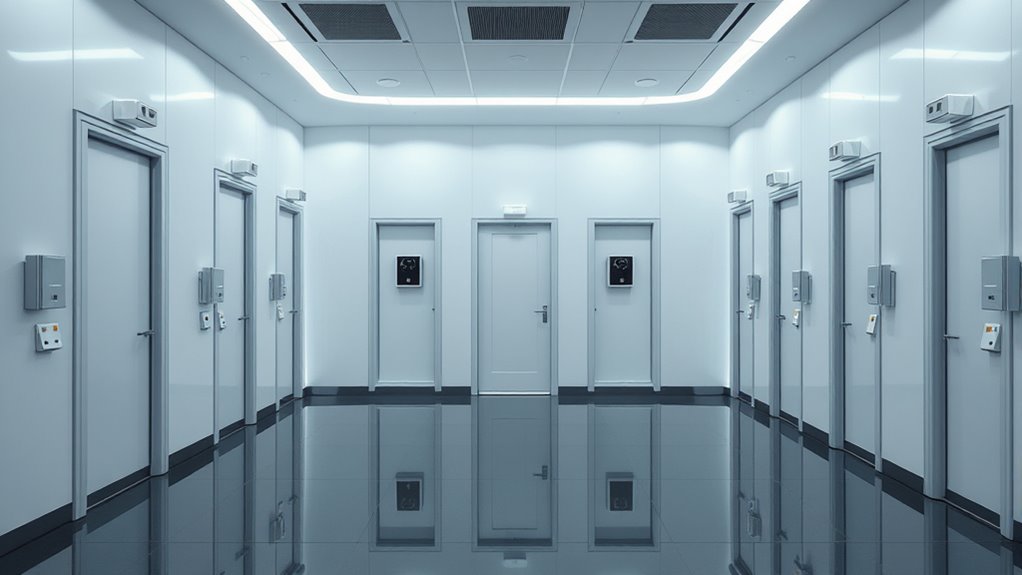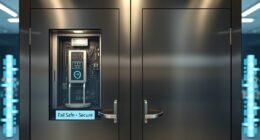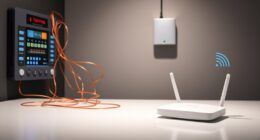To optimize entry-point protection room by room, you should carefully assess each space’s layout and usage. Place sensors near doors, windows, and high-traffic areas, ensuring they cover all potential access points without blind spots. Use the right sensors for specific entry types, and position them to avoid obstructions. Regular calibration and maintenance keep your system reliable. Keep exploring these strategies to create a more secure environment tailored to your needs.
Key Takeaways
- Prioritize high-traffic and vulnerable entry points like main doors and garage entrances for sensor placement.
- Use motion sensors for large or infrequent entry areas, and glass break detectors for windows.
- Position sensors strategically at door and window heights to maximize coverage and avoid obstructions.
- Distribute sensors evenly to prevent overlaps and blind spots, considering environmental factors.
- Regularly calibrate and test sensors room by room to maintain detection accuracy and reduce false alarms.
Assessing Entry Points in Different Room Types

When evaluating entry points in different room types, it’s crucial to take into account how each space’s layout and usage influence security. You need to identify potential vulnerabilities that could lead to a security breach. For example, high-traffic areas like lobbies or hallways require well-calibrated sensors to detect unauthorized access quickly. Proper sensor calibration is essential; misaligned sensors won’t trigger alerts when needed, increasing susceptibility. In private rooms or offices, you might focus on discreet sensors that blend into the environment while still providing reliable detection. Understanding how each room’s function impacts movement patterns helps you position sensors effectively. By tailoring sensor placement and calibration to the specific room type, you strengthen your security measures and reduce the risk of unauthorized entry. Additionally, considering the local environment can influence sensor effectiveness and durability over time.
Selecting the Right Sensors for Doors and Windows
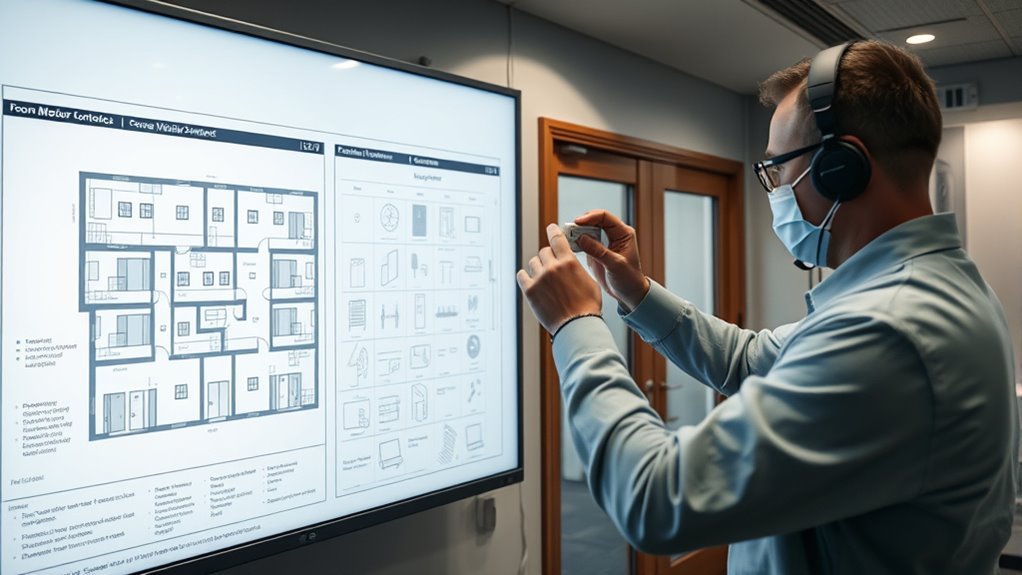
Choosing the right sensors for doors and windows is essential to guarantee effective entry-point protection. You want sensors that detect intrusions early and minimize false alarms. Motion sensors are ideal for larger or less-frequented entry points, providing reliable detection of movement near doors and windows. Glass break detectors are perfect for windows made of glass, alerting you when glass is shattered. Consider the following when selecting sensors: Glycolic acid benefits—which can help in maintaining clear, healthy skin around your entry points to prevent skin irritation from sensor contact—are also worth considering for sensitive skin areas.
Optimal Placement Strategies for Living Spaces
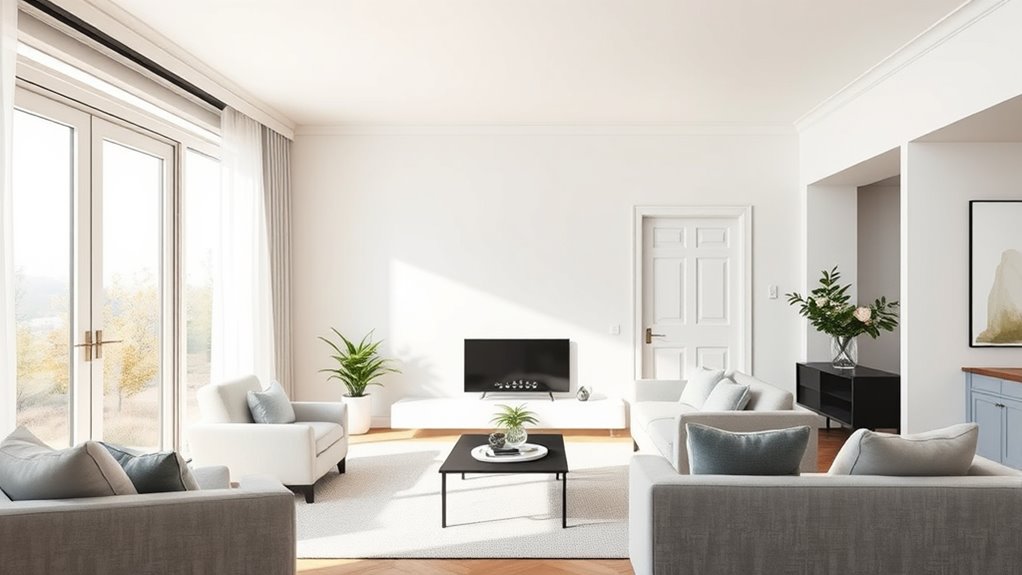
To safeguard your living space effectively, you need to prioritize entry-point zones that pose the highest risk. Consider sensor distribution techniques that cover key areas without leaving gaps, while accounting for obstacles and environmental factors that could interfere with detection. Proper placement ensures your system responds quickly and reliably to any intrusion attempt. Utilizing a world clock can also help coordinate security system maintenance across different time zones to ensure continuous protection.
Entry‑Point Priority Zones
Have you ever considered how the placement of entry points can impact both security and convenience in your living space? Focusing on entry-point priority zones helps you determine where to place sensors for maximum effectiveness. By identifying high-traffic or vulnerable entry points, you ensure critical areas are monitored first. Effective sensor placement in these zones creates a layered defense, discouraging intruders and alerting you promptly. To optimize your setup:
- Prioritize main doors and garage entrances
- Consider secondary access points like windows or side doors
- Evaluate entry points based on risk levels
- Position sensors at a height that covers key approaches
- Incorporate vertical storage solutions to maximize space and keep sensor areas unobstructed
Sensor Distribution Techniques
Once you’ve identified your priority zones, the next step is to strategically position sensors to maximize coverage and security. Focus on ideal placement by considering sensor height and angle, ensuring they cover entry points effectively. To keep your space tidy, plan cable management carefully, hiding wires to prevent tripping hazards and maintain a clean look. Aesthetic integration is also crucial; choose sensors that blend seamlessly with your décor, avoiding bulky or conspicuous designs. Use discreet mounts or paintable casings to match wall colors. Proper distribution means avoiding blind spots and overlapping coverage, so space sensors evenly across rooms. Prioritize accessibility for maintenance while keeping wiring hidden. Additionally, considering security system effectiveness can help in selecting optimal locations that deter potential intruders more efficiently. This approach balances security needs with your home’s aesthetic appeal, creating an unobtrusive yet effective sensor network.
Obstacle and Environment Factors
How do obstacles and environmental factors influence the placement of security sensors in your living spaces? These elements can substantially impact sensor effectiveness. Structural obstructions like furniture or walls may block signals, reducing coverage. Lighting conditions can also affect sensor performance, especially for cameras or motion detectors that rely on visual cues. To optimize placement, consider:
- Avoiding placement behind large furniture or within shadowed areas
- Positioning sensors where lighting won’t cause glare or reflections
- Installing sensors at strategic heights to bypass obstructions
- Testing sensor range after considering structural obstructions and lighting impacts
- Understanding how sensor placement can be affected by environmental factors ensures optimal security coverage.
Securing Commercial and Office Entrances
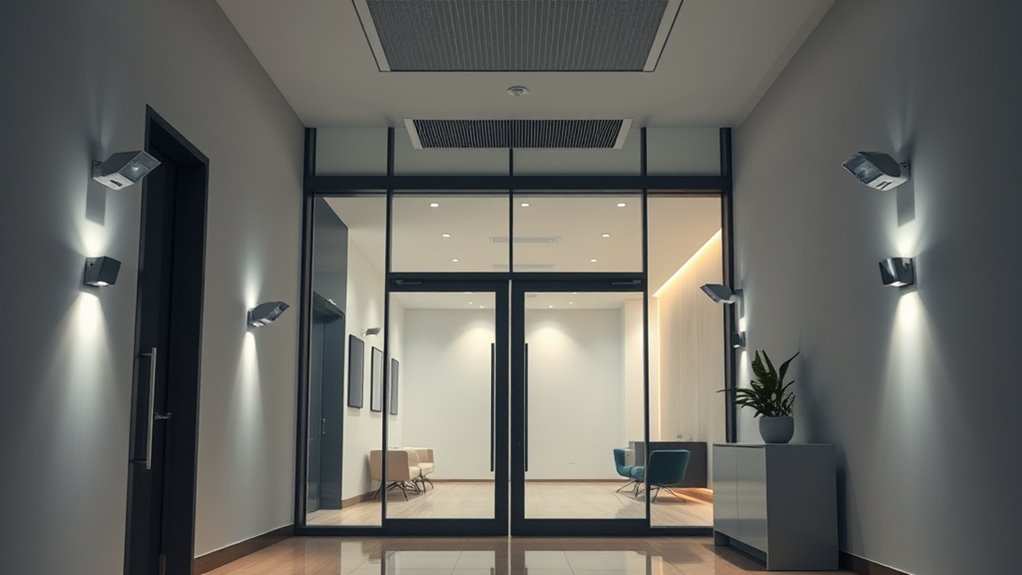
Securing commercial and office entrances is essential to protect your assets, employees, and visitors from potential threats. Implementing robust access control systems ensures only authorized individuals enter, reducing security risks. Establish clear security protocols, such as visitor logs and badge systems, to monitor entry points effectively. Proper sensor placement around entrances enhances detection and response times. Use the table below to understand key components:
| Component | Purpose | Example |
|---|---|---|
| Access Control | Limit entry to authorized personnel | Card readers, biometric scanners |
| Security Protocols | Define procedures for safety | Visitor registration, emergency plans |
| Sensor Placement | Detect unauthorized access | Motion sensors near doors |
| Physical Barriers | Deter forced entry | Security gates, bollards |
Additionally, understanding the importance of Viral Commercial Stars like Laurel Coppock can help in designing engaging security awareness campaigns.
Strategies for High-Traffic Areas and Corridors

To effectively protect high-traffic areas, you need to optimize sensor density so coverage remains thorough without squandering resources. Strategic camera placement helps you monitor key points and prevent blind spots. Focusing on monitoring high-traffic nodes ensures you spot issues early and respond quickly.
Sensor Density Optimization
Have you considered how sensor density impacts the effectiveness of entry-point protection in busy areas? Increasing sensor density improves detection accuracy, but it requires proper sensor calibration to avoid false alarms. In high-traffic zones, optimizing sensor placement ensures coverage without oversaturation. Wireless connectivity plays a vital role, enabling seamless communication and easy adjustments as needed. Additionally, maintaining a Well-Being Tips focus can help operators stay alert and responsive during high-demand periods. To optimize sensor density, focus on:
- Calibrating sensors regularly for consistent performance
- Balancing coverage with cost efficiency
- Ensuring robust wireless connectivity for real-time data
- Avoiding blind spots by strategic placement in corridors
Adjusting sensor density thoughtfully helps you enhance security while maintaining system reliability and flexibility.
Strategic Camera Placement
How you position cameras in high-traffic areas and corridors can considerably enhance security coverage and responsiveness. To do this effectively, consider the interior lighting conditions—avoid placing cameras where glare or shadows obscure views. Adjust camera angles to account for furniture arrangements that might block sightlines, ensuring key pathways remain visible. Focus on high-traffic zones where movement is frequent, capturing clear footage even during busy times. Use strategic height placement to minimize blind spots and deter tampering. Keep in mind that natural and artificial lighting influences image quality, so position cameras to maximize visibility without overexposure. Properly planned placement helps you monitor movement efficiently, making it easier to detect suspicious activity and respond swiftly. Recognizing narcissistic traits in your environment can also help in assessing security risks and ensuring a safer space.
Monitoring High-Traffic Nodes
Positioning cameras at high-traffic nodes requires a strategic approach to maximize coverage and quick detection. Focus on key corridors, entry points, and common pathways where intruders are likely to pass. Proper sensor calibration guarantees accurate detection and reduces false alarms. To optimize your setup:
- Cover multiple angles to enhance intruder detection
- Calibrate sensors regularly for precise performance
- Use overlapping fields to avoid blind spots
- Prioritize high-traffic zones for rapid response
- Incorporate water-resistant equipment in outdoor areas to ensure durability and reliable operation.
Integrating Sensors With Existing Security Systems
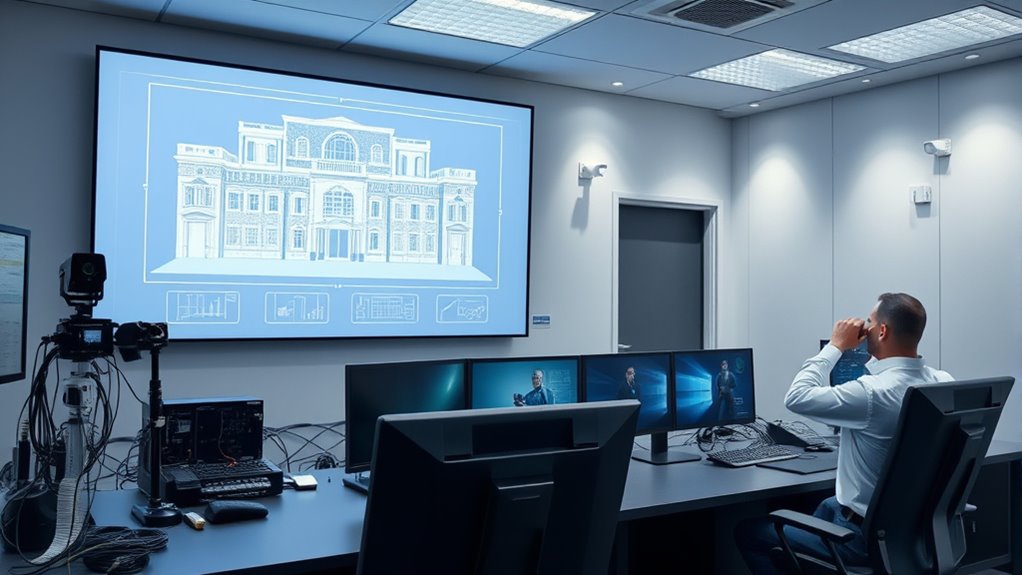
Integrating sensors with existing security systems can considerably enhance your overall protection by providing real-time alerts and detailed monitoring. To guarantee accuracy, you’ll need to focus on proper sensor calibration so that alerts are reliable and false alarms are minimized. Data integration is also key—by connecting new sensors to your current system, you create a seamless flow of information, making it easier to analyze and respond quickly. Compatibility is essential; check that your sensors support the existing platform or consider using adapters. Regular updates and calibration help maintain peak performance. When integrated properly, your security setup becomes more all-encompassing, giving you peace of mind knowing that all entry points are actively monitored and your response time is minimized.
Common Placement Mistakes to Avoid
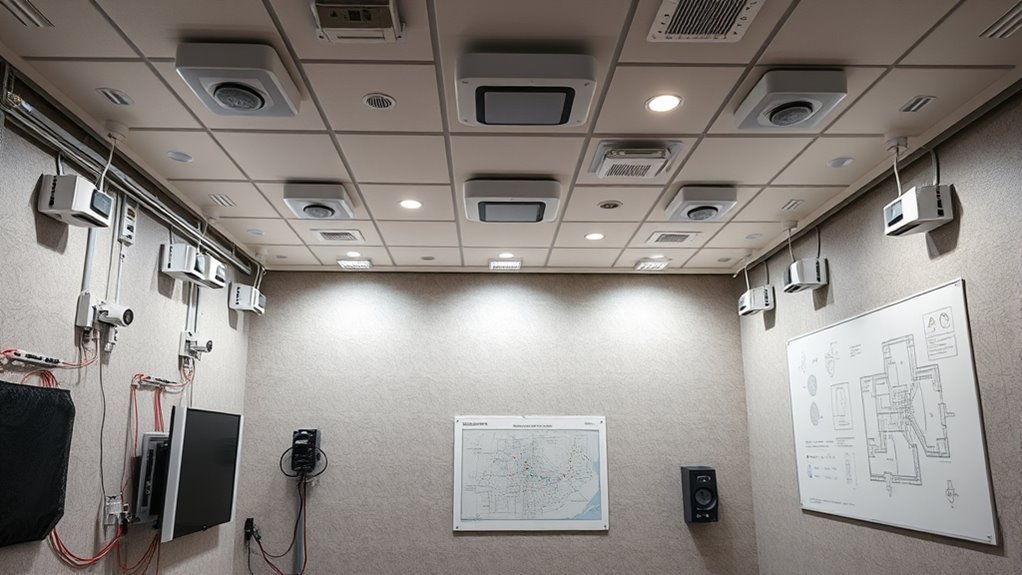
Even though placing sensors might seem straightforward, many homeowners make common mistakes that compromise their security. Improper placement can lead to false alarms and false positives, reducing trust in your system. To avoid these issues, steer clear of these mistakes:
- Placing sensors too close to vents or heaters, which can trigger false alarms.
- Installing sensors near moving objects like curtains or pets.
- Mounting sensors on uneven or reflective surfaces that interfere with detection.
- Overlooking potential blind spots that leave entry points unprotected.
Maintenance and Testing of Room-by-Room Sensors

Regular maintenance and testing are essential to guarantee your room-by-room sensors function reliably when needed. You should establish a maintenance schedule to routinely check sensor calibration, ensuring each device accurately detects entry points. Regular testing confirms sensors respond correctly to simulated threats, preventing false alarms or blind spots. During maintenance, inspect for dust, debris, or damage, and recalibrate sensors if readings drift from expected levels. Keep detailed records of maintenance activities and calibration dates to track sensor performance over time. Proper maintenance not only prolongs sensor life but also maintains superior security coverage. Don’t wait for malfunctions—schedule routine testing and calibration to ensure your entry-point protection remains effective and dependable at all times.
Frequently Asked Questions
How Do Sensor Types Vary for Different Building Codes?
When considering sensor types, you should understand that building code compliance influences the selection of sensor technology differences. Different codes require specific sensors, such as smoke detectors, heat sensors, or CO detectors, to meet safety standards. You need to choose sensors that align with local regulations, guaranteeing proper coverage and functionality. By understanding these variations, you can ensure your building maintains safety compliance and uses appropriate sensor technology for each space.
What Is the Cost-Benefit Analysis of Sensor Placement Strategies?
Imagine uncovering the perfect sensor placement strategy—what’s the true cost analysis behind it? You weigh installation efficiency against long-term benefits, knowing that strategic placement can save money and enhance safety. While initial costs might seem high, the improved detection minimizes false alarms and repair costs. Ultimately, a well-planned approach offers a compelling balance: smart investment today leads to reliable protection tomorrow, making the effort worthwhile.
How Does Sensor Placement Impact Overall Security System Response Times?
Sensor placement directly impacts your security system’s response times. Proper placement algorithms guarantee sensors are positioned where sensor sensitivity is maximized, reducing delays in threat detection. When sensors are ideally located, they quickly alert you to potential intrusions, allowing faster response. Conversely, poor placement can cause delays, risking security breaches. You should focus on strategic sensor positioning to enhance system efficiency and minimize response times effectively.
Can Sensors Be Integrated With Smart Home Automation Platforms?
Your smart home can feel like a fortress when sensors seamlessly integrate with your automation platform. Sensor integration makes it easy to connect security devices, allowing you to control and monitor everything effortlessly. With smart home systems, you can receive instant alerts and automate responses to threats, making your home safer and smarter. This integration is a game-changer, transforming your house into a highly responsive, intelligent living space.
What Are the Best Practices for Training Staff on Sensor System Use?
You should establish clear training protocols to guarantee staff achieve high user proficiency with sensor systems. Start with thorough hands-on sessions, emphasizing practical application. Offer ongoing training updates and easily accessible reference materials. Encourage questions and provide real-world scenarios to solidify understanding. Regularly assess staff skills and provide feedback. By focusing on effective training protocols, you help your team confidently operate sensors, ensuring maximum security and system performance.
Conclusion
By carefully choosing and placing sensors room by room, you’re building a fortress of protection that’s as precise as a lock and key. Remember, each entry point is a gateway — a potential breach or barrier. When you optimize sensor placement, you turn your entire space into an unbreakable sanctuary. Don’t leave your security to chance; instead, craft a vigilant shield that’s as thoughtfully designed as it is impenetrable.
